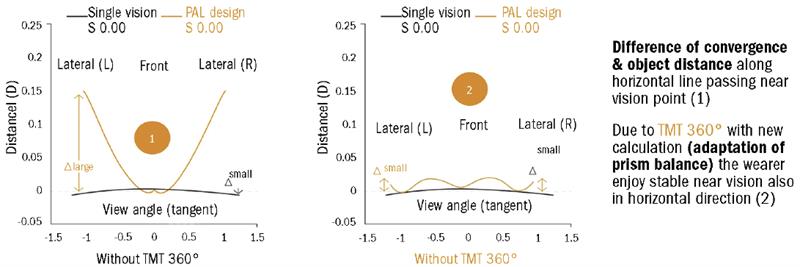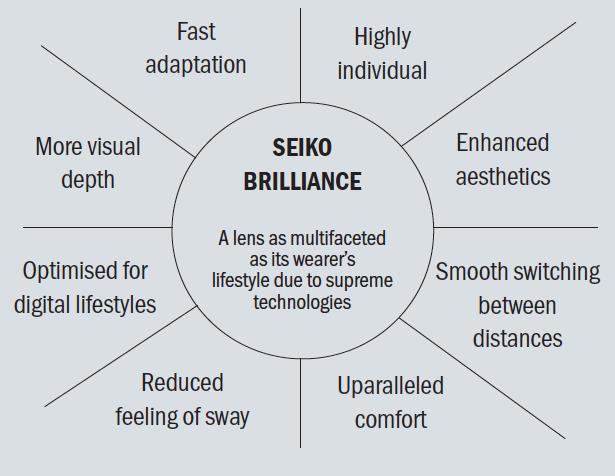
Spectacle lens wearers can often experience challenges when switching to progressive lenses, such as dizziness and feelings of sway. Due to a combination of technologies, Seiko Brilliance pushes forward progressive vision to a new level. With precise customisation and high levels of aesthetics the lens is designed to provide supreme vision for all lifestyles that demand maximum precision.
The way we see the world is changing, our eyes are facing new challenges. The increasing use of digital devices means
our visual system is forced to cope with accommodation and convergence over increasingly long periods of time.1 With the closer working distances that regular smartphone use dictates, near distances have also reduced by almost half, to between 20 to 30cm.2-5
Demographic changes are increasing the potential number of progressive lens wearers.6,7 Nowadays, we use progressive lenses for nearly half of our lives.8
When using smaller displays, frequent focusing on specific areas with extremely small text sizes has led to a desire, and a need, for spectacle lenses that enable relaxed vision with clear imaging over prolonged periods of time.5
Seiko Brilliance
Seiko Brilliance builds on the current progressive lens portfolio; it is an addition to the range rather than a replacement to any of the current progressive lenses. Seiko Brilliance provides the utmost level of customisation, as not only are the lenses made to the wearer’s individual facial or frame parameters, the design will also be based on the wearer’s personal lifestyle preference.

This improved level of personalisation is driven by the introduction of the Personal Design Selector (PDS), a web-based tool that enables an eye care practitioner to capture the wearer’s lifestyle preference, previous progressive lens history and prescription, to produce a lens design code that allows the design to be adapted to suit the wearer’s individual needs.
In addition to the higher level of personalisation Seiko Brilliance introduces four additional technologies.
Next generation binocular vision
Seiko has significantly advanced the TMT technology launched in 2016. This technology offers effortless and quick focusing, consistent visual stability and improved depth of focus, resulting in TMT 360°. It increases spontaneous tolerance and reduces symptoms of fatigue, irrespective of the direction of vision, viewing distance and frequency of changes of view.
The optimised power distribution of unwanted prismatic effects due to differences in power between the right and left prescriptions now occurs in the vertical and horizontal directions. The binocular visual fields are coordinated with one another in the intermediate and near vision areas.
The progressive power distribution of simple progressive lenses produces unwanted prismatic effects with horizontal changes of view. The unequal distortions that result between each eye can impair binocular vision and binocular fixation. In a nutshell, Seiko Brilliance manages to control the unwanted prismatic effect and improve binocular performance when the eyes move laterally as well as vertically.
Lenses for the digital age
Digital Zoom Equalizer creates wider intermediate and near vision areas due to an adapted calculation of astigmatic effects. The astigmatic power and axis positions are added in a controlled manner during the calculation process with it calculated and produced separately for the near portion allowing the distance portion to be unaffected or reduced in size. In addition to a noticeable gain in the intermediate and near areas, the transition becomes more relaxed and vision more comfortable.
Digital Zoom Equalizer makes it easier for the visual system to function at different near distances, such as when using smartphones.
Balanced aesthetics
With higher prescriptions, the appearance of the lens itself, as well as the appearance of the wearer will be influenced by the prescription value. Add to this the increased edge or centre thickness and the resulting increase in magnification or ‘minification’ of the wearer’s facial contours and eye size. This leads to the eyes losing their natural appearance and the wearer’s facial contours being affected.
By adjusting the existing differences in image scale and lens thickness in certain areas, Seiko makes it possible to positively change the appearance of the Brilliance lens and the wearer. The surface of the lens is divided into two areas: the central area is responsible for best possible optical imaging and visual quality, while the outer area contributes to aesthetic optimisation. The lens radii are modified and cosmetics are enhanced by changing lens thicknesses.
All of this has been achieved while full visual quality and acuity is provided in both areas.
Distortion and Imaging
Ideally, natural vision means clear vision – as if there are no spectacles at all. For those with presbyopia, this is not always possible, the reading addition results in magnification due to the extra additional positive power. Consequently, progressive lens wearers must learn to accept distortion and different image ratios from their lenses.
To effectively influence distortion and image ratio control within the Seiko Brilliance product, the distribution of the add power is optimised across the lens surfaces. The lens considers the specific properties of the images created by the prescription and addition for the intermediate and near vision areas to enhance them and provide a much more natural image size.
Wearer feedback
Prior to the launch of Seiko Brilliance, customers were given the opportunity to try out the new lens. The testimonies that were received certainly bore out the benefits expected from this premium progressive lens. Unsurprisingly to Seiko, ‘brilliant’ was the most used term to describe the overall lens performance. The adaptation to the lens was also found to be much easier, with an easy transition from many differing previous lens designs.
Wearer benefits of SEIKO Brilliance

Opportunities for the practice
The dispensing process for such a premium personalised progressive lens was also a key consideration. Seiko Brilliance does not require any additional equipment; internet access is all that is needed to enable the completion of the Personal Design Selector tool. The completion of the PDS will also compliment the dispensing consultation: the PDS fits seamlessly into the dispensing process while enabling the ECP to demonstrate the higher level of personalisation and added value that this brings to the wearer experience.
The aim of Seiko Brilliance is to provide ECPs with a progressive lens they can feel confident to recommend, with little or no adaptation issues, high performance across the visual areas and the opportunity to meet the needs of today’s increasing presbyopic market.
For further information about Seiko Brilliance visit www.Seikovision.com/uk/lenses/progressive/Seiko-brilliance
Michelle Lloyd-Bibb, is professional services manager at Seiko UK.
References
- Schumacher L. Just How Much Time Do We Spend Each Day With Digital Media? eMarketer. April, 2014, http://www.vicimediainc.com/just-much-time-spend-d... [Accessed 25.08.2020]
- GlobalWebIndex. Survey based – Internet users 16-64 years. Q2-Q3 2017.
- comScore Inc. MMX Multi-Platform, January 2017. http://www.smartinsights.com/mobile-marketing/mobi... [Accessed 25.08.2020]
- Think with Google. New Data. How people use their devices. 09-2016
- Bababekova Y, Rosenfield M, Hue JE, Huang RR. Font Size and Viewing Distance of Handheld Smart Phones. Optometry & Vision Science. 88(7):795-797, 07- 2011.
- United Nations, Department of Economic and Social Affairs, Population Division (2013). World Population Ageing 2013. ST/ESA/SER.A/348. https://www.un.org/en/development/desa/population/... [Accessed 25.08.2020]
- United Nations, Department of Economic and Social Affairs, Population Division (2017). World Population Prospects: The 2017 Revision / https://ourworldindata.org/age-structure[Accessed 25.08.2020]
- Charman WN. Developments in the correction of presbyopia I: spectacle and contact lenses. Ophthalmic Physiol Opt. 2014;34(1):8-29. doi:10.1111/opo.12091

